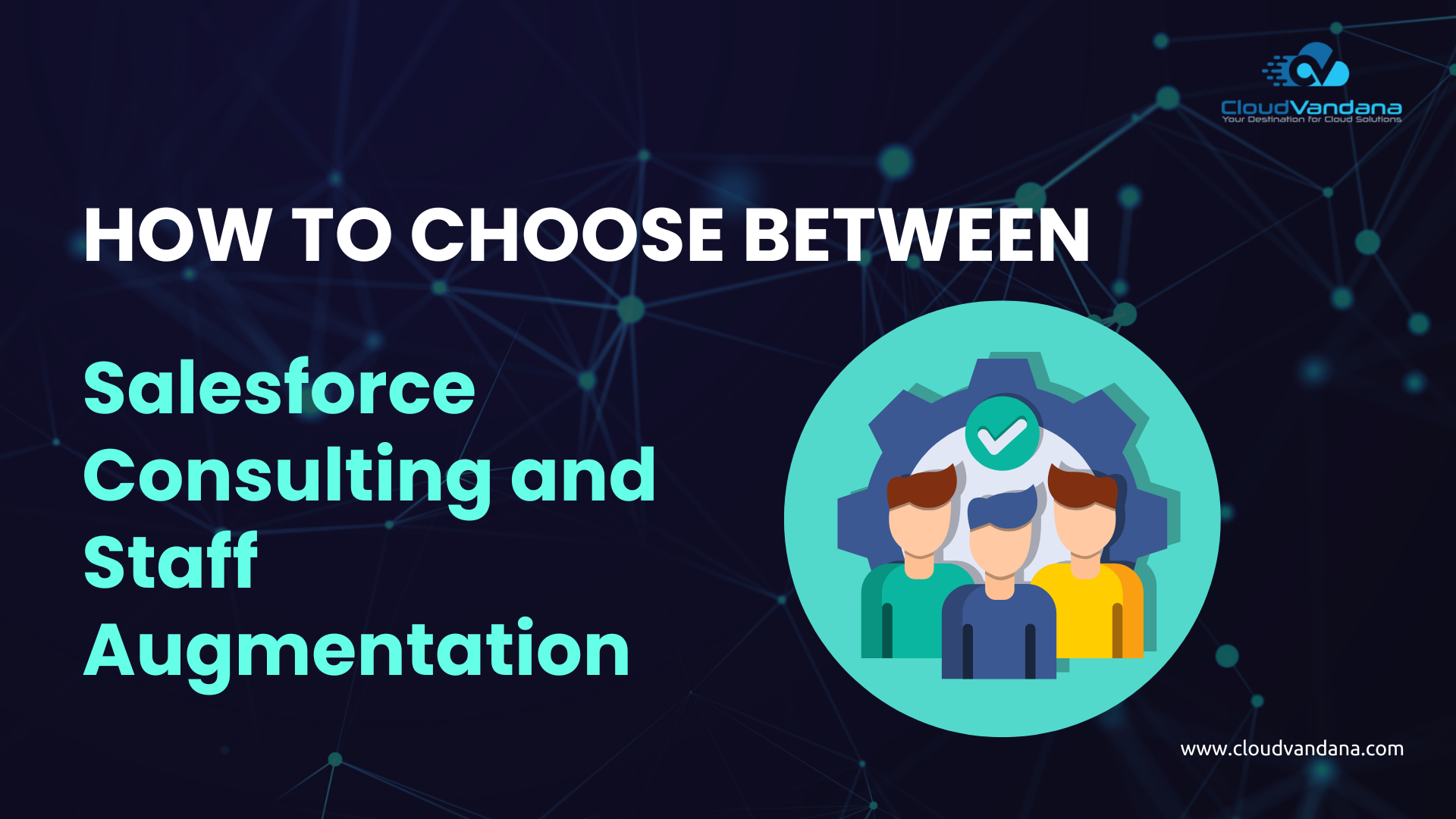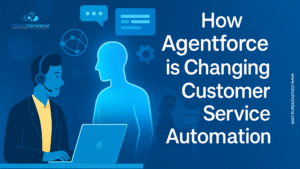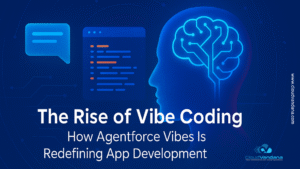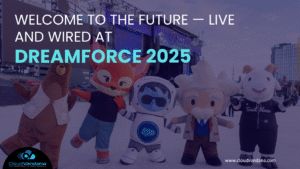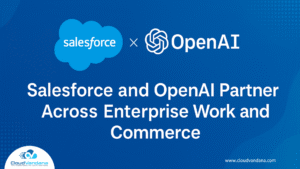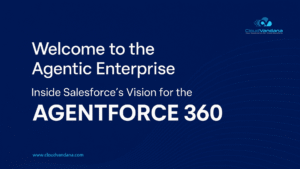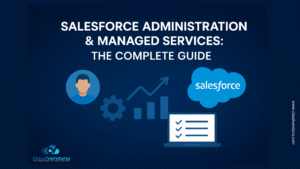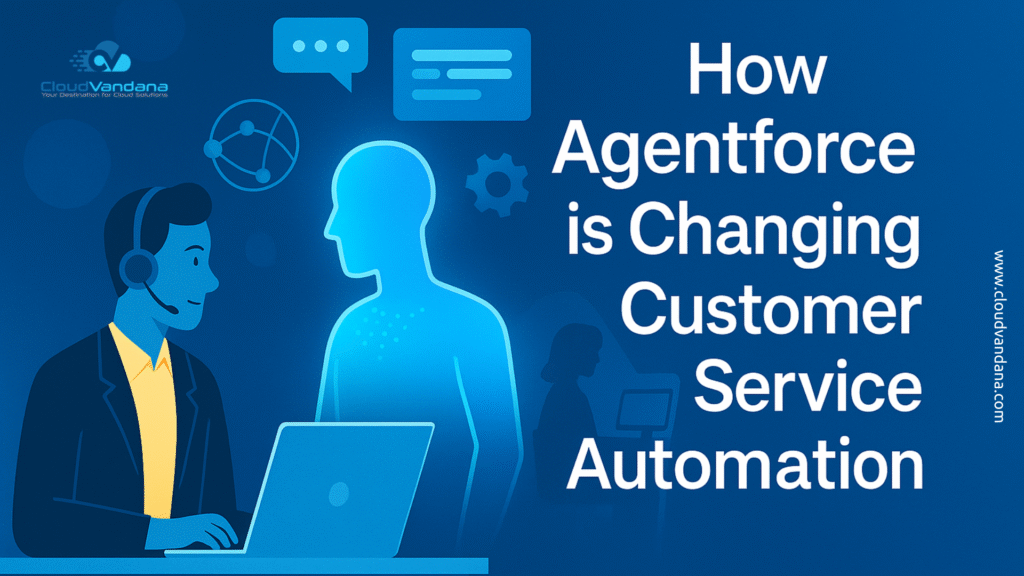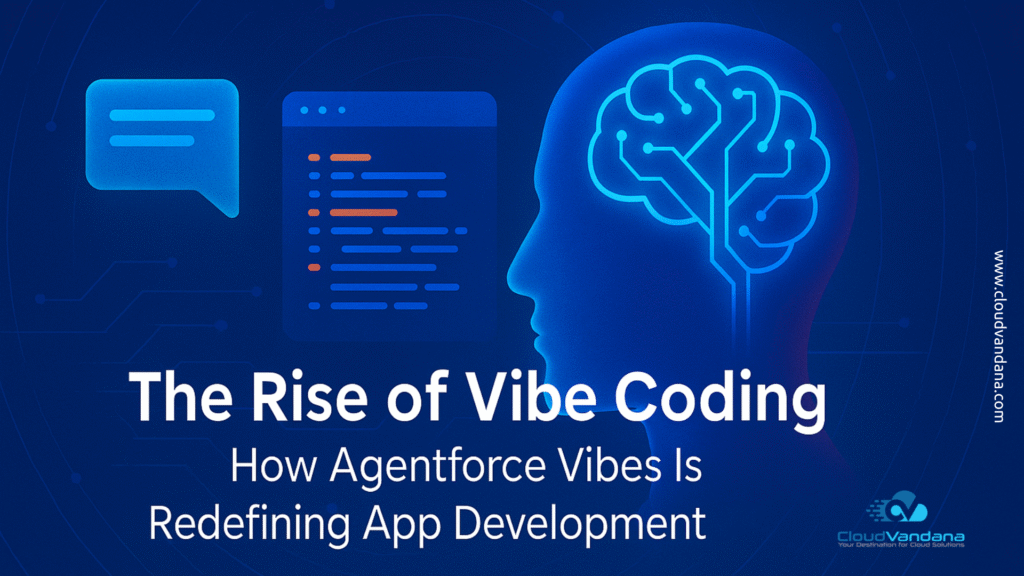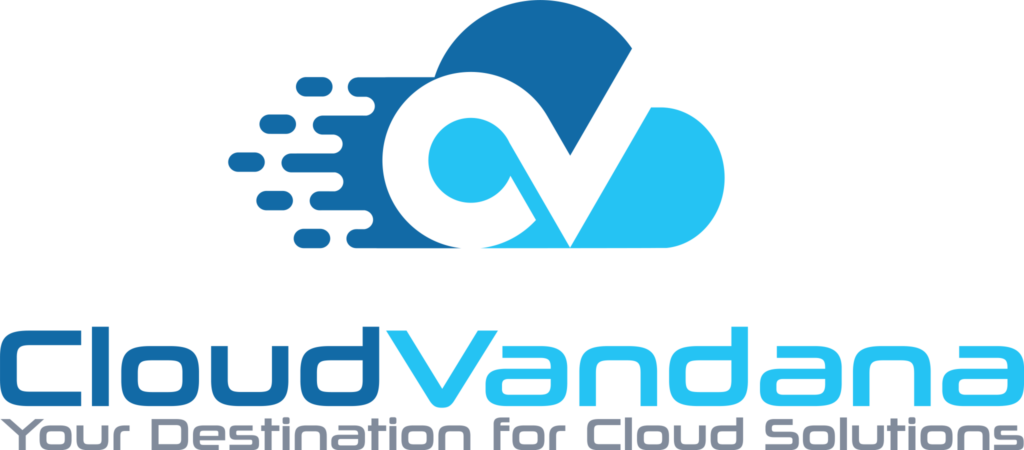Introduction: The Crossroads of Salesforce Growth
Every organization that invests in Salesforce eventually encounters a turning point—a moment when the platform that once felt like a straightforward customer relationship management (CRM) solution evolves into something far more complex. What begins as a tool for managing leads and opportunities gradually grows into a mission-critical ecosystem. It expands across departments, powering sales, service, marketing, analytics, and increasingly, artificial intelligence–driven automation.
At the early stage, a single internal administrator or developer often suffices. They can configure dashboards, manage users, and build simple workflows to keep the engine running. But as the business scales and customer expectations rise, the cracks in this model become undeniable. Integrating multiple Salesforce clouds, ensuring compliance with ever-tightening regulations, and managing vast, interconnected datasets push beyond the comfort zone of a small internal team. Issues like technical debt, lack of governance, or poorly designed integrations begin to surface, threatening the stability of the entire operation.
At this critical juncture, leadership must make a decisive choice. They can either bring in a Salesforce consulting partner—armed with architects, strategists, and industry playbooks—to design and deliver a structured transformation, or they can reinforce their existing workforce through staff augmentation by embedding specialized professionals who provide the extra capacity and skills needed to keep projects moving.
This decision is far more consequential than it appears on the surface. It is not simply an operational adjustment—it is a strategic inflection point. Choosing the wrong path can lead to ballooning costs, delayed rollouts, stalled innovation, and frustrated end-users. Months of effort and millions of dollars can evaporate if execution outpaces vision or if strategy lacks the muscle to deliver. But when organizations choose wisely, Salesforce transforms from a mere business tool into a true competitive differentiator—an engine of agility, growth, and sustained advantage in an increasingly digital-first marketplace.
Table of Contents
- Introduction: The Crossroads of Salesforce Growth
- Why Salesforce Expertise Has Become a Strategic Imperative
- Defining Salesforce Consulting
- Understanding Staff Augmentation
- Key Differences Between Consulting and Staff Augmentation
- Business Scenarios That Call for Consulting
- Business Scenarios That Call for Staff Augmentation
- The Cost Dimension: Investment vs. Budget Control
- Risk Management: Accountability in Each Model
- Speed of Execution: Who Delivers Faster Results?
- Knowledge Transfer: Building Internal Capability
- Cultural Alignment and Team Integration
- The Role of Certifications and Partner Ecosystems
- When to Blend Consulting with Augmentation
- Common Pitfalls in Choosing the Wrong Model
- Decision-Making Framework: Questions Leaders Must Ask
- Industry Examples: Consulting Success Stories
- Industry Examples: Staff Augmentation Success Stories
- The Future of Salesforce Resourcing Models
- Conclusion: A Balanced Path to Sustainable Salesforce Success
- Frequently Asked Questions (FAQs)
- YOU MIGHT ALSO LIKE
Why Salesforce Expertise Has Become a Strategic Imperative
Salesforce has evolved into a digital nervous system for modern enterprises. No longer confined to pipeline tracking, it powers Data Cloud to unify customer information, industry-specific solutions like Financial Services Cloud or Health Cloud, and Agentforce to deliver AI-driven agents capable of handling service requests, compliance checks, and even sales guidance.
Yet this very power introduces staggering complexity. A poorly designed object model can choke reporting accuracy. A rushed integration with an ERP system can create data silos that undermine decision-making. Compliance oversights can expose organizations to fines and reputational damage. According to a 2024 Forrester survey, companies that approached Salesforce projects without expert involvement were three times more likely to face stalled adoption within two years.
In a hyper-competitive environment, missteps like these are not trivial—they are existential. Expertise in Salesforce has shifted from being a “nice to have” to a strategic imperative. Without it, organizations risk building digital houses on shaky foundations. With it, they gain agility, foresight, and a pathway to outperform competitors.
Defining Salesforce Consulting
Core scope of consulting engagements
Salesforce consulting engagements are not about adding extra hands. They are about bringing in strategic partners who can view the enterprise holistically. Consultants begin by conducting discovery workshops, interviewing stakeholders, and mapping business processes to identify inefficiencies. From there, they design target-state architectures—blueprints that not only solve immediate challenges but also anticipate future growth.
A consulting engagement might include:
- Designing a multi-cloud strategy to unify sales, service, and marketing.
- Building scalable data architectures that support predictive analytics.
- Embedding automation frameworks to streamline sales approvals or case escalations.
- Establishing change management roadmaps to ensure employees adopt new processes.
These engagements are outcome-focused, often measured not by hours logged but by transformation milestones achieved.
The role of certified consultants and architects
Certified Salesforce consultants and architects carry a level of credibility that goes beyond badges. They’ve seen patterns repeat across industries and know the pitfalls to avoid. For example, a Salesforce Technical Architect understands not just how to configure APIs but how to orchestrate them in a way that safeguards scalability and compliance.
They are strategists, engineers, and change agents combined. Their job is to make sure technology serves the business, not the other way around. And because consulting firms often employ teams rather than individuals, clients gain access to a collective brain trust—specialists in integration, analytics, and industry-specific compliance—all under one roof.
Understanding Staff Augmentation
What augmentation means in practice
Staff augmentation is fundamentally different. Instead of outsourcing strategy and ownership, companies embed external Salesforce professionals into their teams. These individuals follow internal leadership and execute tasks as if they were employees.
It’s akin to renting specialized muscle—you retain control of direction, while the augmented staff deliver execution power. This approach is especially common in organizations that already have a mature internal Salesforce strategy but lack the bandwidth to execute it.
Typical roles businesses add through augmentation
Augmented professionals come in many forms:
- Salesforce Administrators: Manage day-to-day system health, users, and workflows.
- Developers: Build custom applications, triggers, and integrations.
- Business Analysts: Translate stakeholder requirements into actionable user stories.
- QA Testers: Ensure new releases don’t break existing functionality.
- Release Managers: Orchestrate deployments and change sets.
These roles blend seamlessly with internal staff, often participating in standups, sprint planning, and backlog refinement sessions.
Key Differences Between Consulting and Staff Augmentation
Strategic advisory vs. tactical execution
Consultants serve as strategic advisors. They envision the future state, design scalable solutions, and assume accountability for outcomes. Augmented staff, by contrast, are tactical executors. They help clear backlogs, deliver features, and support day-to-day operations.
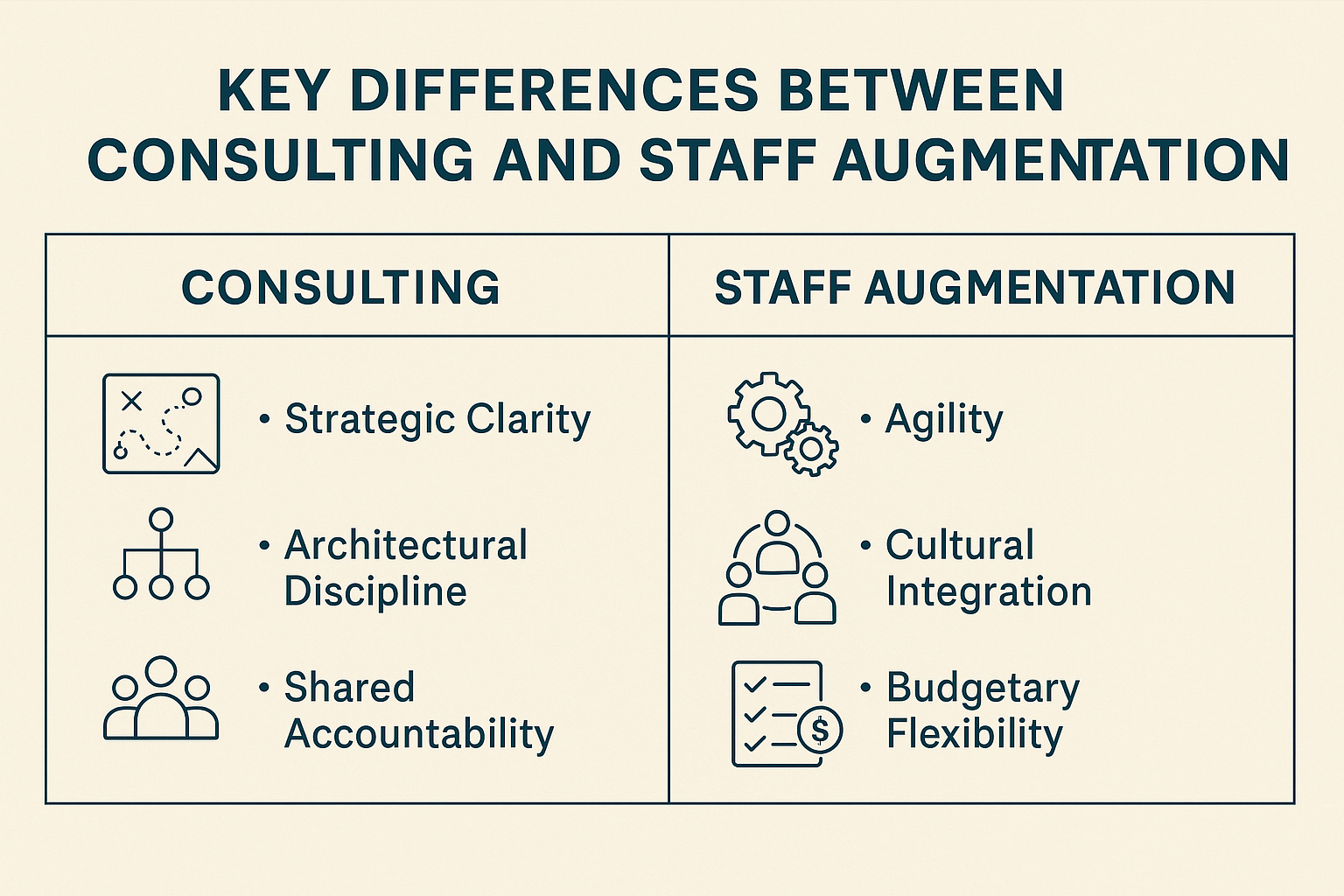
Duration and scope of involvement
Consulting engagements typically have a defined scope—such as a Service Cloud rollout or Data Cloud integration. Once completed, the consultants may exit or shift into support roles. Staff augmentation, however, is open-ended. Professionals can remain embedded for weeks, months, or even years.
Ownership of outcomes
In consulting, accountability for deliverables rests with the partner. If the project underdelivers, the consulting firm shares responsibility. In augmentation, outcomes are owned internally. The augmented staff follow your roadmap, but success or failure depends on your leadership.
Business Scenarios That Call for Consulting
Large-scale digital transformation
When an enterprise decides to reimagine customer engagement end-to-end, consulting is indispensable. For instance, a global bank undertaking a multi-cloud rollout cannot rely on a handful of augmented developers. It needs architects, strategists, and change leaders who can guide a multi-year transformation.
Complex integrations and architecture redesign
Connecting Salesforce with ERP, data warehouses, or AI-driven analytics requires architectural foresight. A poorly designed integration can create data silos, break compliance, and cause operational downtime. Consultants bring the frameworks to handle such complexity.
Regulatory compliance and data governance
In industries such as healthcare, finance, or public sector, compliance failures can lead to fines and reputational damage. Consulting firms specialize in embedding governance frameworks and security models that ensure adherence to regulations like HIPAA, GDPR, or FedRAMP.
Business Scenarios That Call for Staff Augmentation
Short-term skill shortages
Consider a company mid-way through a Salesforce CPQ rollout when their only certified developer resigns. Rather than halting the project, they bring in an augmented developer for six months, ensuring continuity without hiring full-time.
Handling project backlogs
Internal teams are often swamped with enhancement requests. Staff augmentation provides immediate relief by increasing velocity, reducing backlog, and meeting deadlines without burning out internal employees.
Scaling without permanent hires
Some organizations face seasonal surges. A retailer, for instance, may need additional admins and testers before holiday season campaigns. Staff augmentation allows them to scale quickly and downsize after peak demand.
The Cost Dimension: Investment vs. Budget Control
When evaluating Salesforce resourcing models, cost considerations inevitably rise to the forefront. But cost here is not just about the raw numbers on a contract—it’s about how those numbers translate into value, sustainability, and risk over time.
Consulting engagements often demand significant upfront investment. Hiring a consulting firm is rarely the cheapest option at the outset. Firms bring in certified architects, domain specialists, project managers, and change management experts—all billed at premium rates. Yet this higher initial spend often pays for itself in the long run. Why? Because consulting delivers more than just hours of labor. It delivers strategic alignment, architectural foresight, and the avoidance of costly mistakes.
Imagine constructing a skyscraper. You could rely on a series of freelance builders who each know how to pour concrete or install glass panels, but without a master architect, the structure may collapse under its own weight. Consulting partners act as those architects—ensuring the foundation is solid, the design is scalable, and the end result is sustainable for decades. The return manifests in reduced technical debt, fewer system reworks, and an infrastructure that can handle growth without constant patchwork fixes.
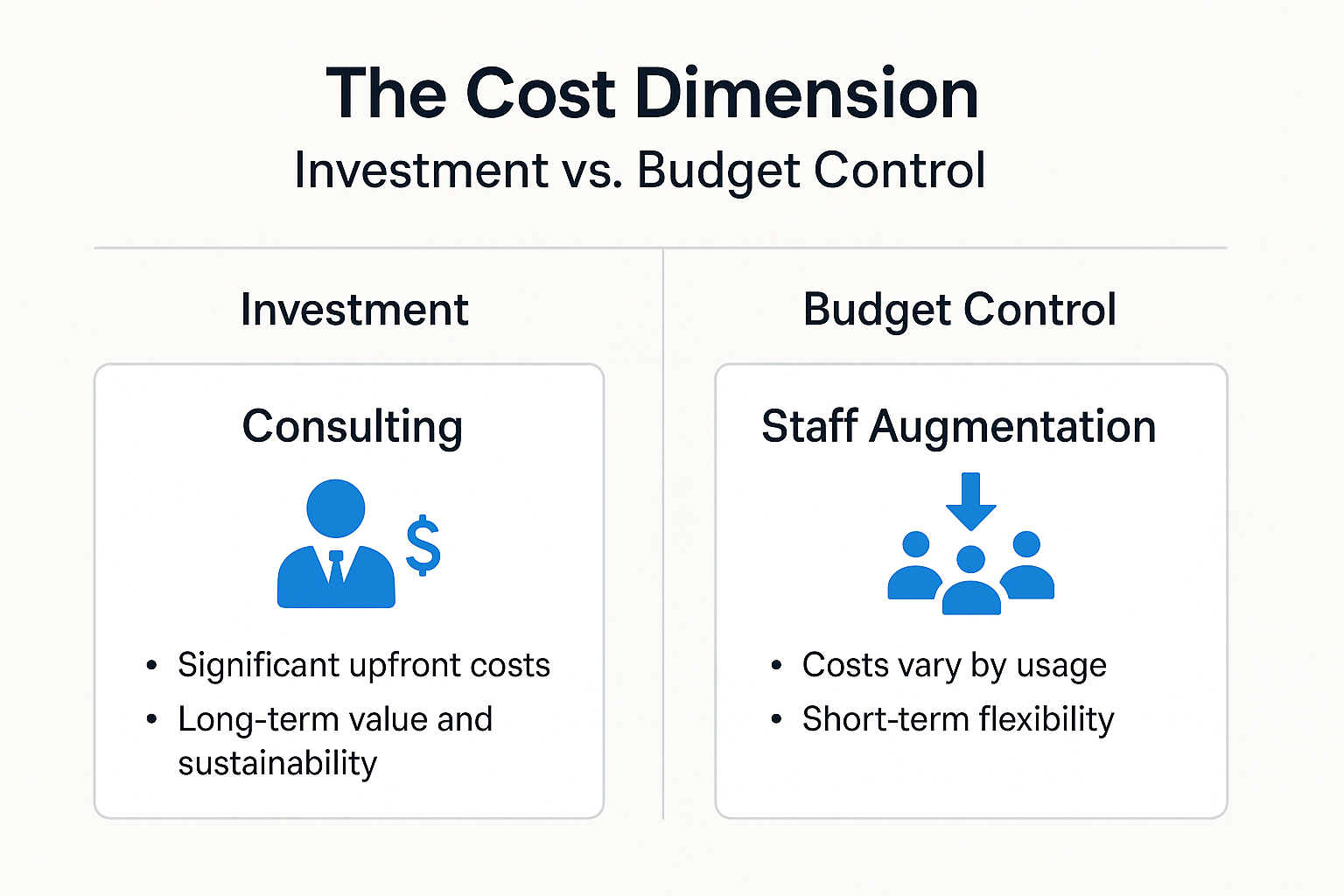
By contrast, staff augmentation provides organizations with greater budgetary flexibility. Instead of committing to a large consulting engagement, companies can contract individual administrators, developers, or analysts on a pay-as-you-go basis. This elasticity allows leaders to scale resources up during peak project demands and scale them down when workloads ease. For companies managing tight budgets or operating in uncertain markets, this approach offers valuable agility.
However, the trade-off is that augmentation places more responsibility on internal leadership. Because augmented professionals work under your direction, the onus falls on your managers to define priorities, oversee deliverables, and ensure resources are effectively utilized. Without strong governance, augmentation can devolve into costly inefficiency—multiple contractors working in silos, duplicating effort, or building short-term fixes that fail to support long-term strategy.
The cost equation, therefore, is not just about expense—it is about investment versus control. Consulting demands higher initial expenditure but safeguards the organization against misaligned strategies and escalating technical debt. Augmentation offers budget flexibility but requires mature internal oversight to ensure dollars spent translate into sustainable value.
Risk Management: Accountability in Each Model
Every business decision carries an element of risk, and Salesforce resourcing models are no exception. The question leaders must confront is not whether risk exists, but who shoulders it.
With consulting engagements, a portion of that risk is transferred to the consulting partner. Firms typically operate under clearly defined contracts, complete with milestones, deliverables, and success criteria. If outcomes fall short—whether due to poor design, missed deadlines, or underperforming solutions—the consulting partner can be held accountable. This arrangement provides a layer of assurance: you are not navigating the complexity of Salesforce alone, and your partner has skin in the game. In effect, the partner shares in both the responsibility and the liability of the project’s success.
Consider a large-scale Service Cloud rollout. If a consulting firm commits to deploying it within nine months, with integration to ERP systems and a set of compliance-ready workflows, the accountability lies squarely with them. If they miss the mark, they must remediate at their own expense or risk reputational damage. This risk-sharing mechanism acts as a buffer, reducing exposure for your internal leadership team.
Staff augmentation, by contrast, internalizes the risk. Augmented professionals embed within your workforce and follow your direction, but the burden of accountability remains entirely in-house. If a project stalls, if integrations break, or if adoption falters, it is the organization—not the augmented staff—who bears responsibility for course correction. These professionals execute tasks, but they do not own strategic outcomes.
This difference forces leaders to weigh their appetite for ownership. If your organization has mature governance, seasoned project managers, and strong internal leadership, you may be comfortable absorbing the risk inherent in augmentation. But if your team lacks experience with large-scale Salesforce initiatives, shifting some of that risk to a consulting partner can provide much-needed protection.
Ultimately, risk management in this context comes down to a fundamental choice: do you prefer to share responsibility with an external partner, or do you prefer to retain full control—even if it means carrying the weight of every failure yourself? The answer depends not only on budget but also on the maturity, confidence, and resilience of your internal team.
Speed of Execution: Who Delivers Faster Results?
Speed in Salesforce projects is always contextual—it depends on whether the bottleneck lies in strategy or in capacity.
Consultants deliver rapid results when complexity is the barrier. Their value lies not only in expertise but also in proven methodologies, accelerators, and playbooks built from past implementations. For instance, a consulting firm that has rolled out Financial Services Cloud dozens of times can anticipate pitfalls, leverage reusable templates, and navigate compliance requirements with minimal trial and error. What might take an internal team a year of experimentation can be completed in months with the right consulting partner.
Staff augmentation, on the other hand, accelerates execution when the bottleneck is bandwidth. If your roadmap is clear but your backlog keeps piling up, adding certified developers, testers, or administrators through augmentation can dramatically speed delivery. These professionals may not redefine strategy, but they help your team push features into production faster, maintain release cadence, and prevent project slowdowns caused by understaffing.
In short: consultants cut through complexity, while augmentation powers through volume. The faster option depends entirely on the nature of the obstacle in front of you.
Knowledge Transfer: Building Internal Capability
One of the overlooked factors in Salesforce resourcing is the question of what knowledge remains in the organization once the project ends. Technology alone cannot sustain growth—people and processes must carry forward the expertise to adapt, troubleshoot, and innovate.
Consultants often approach this with a structured mindset. Knowledge transfer is usually built into their delivery model. Beyond configuring systems, they invest time in conducting workshops, developing playbooks, and training internal teams. These sessions ensure that administrators, power users, and managers understand not just how to use the system, but why it was designed in a particular way. Documentation, governance frameworks, and best practice guides are often handed over at project closeout, leaving behind a stronger, more capable internal team. The goal of good consulting is not only to deliver but to empower organizations for the long run.
Augmented staff, by contrast, focus primarily on execution. While many are highly skilled, they operate under the organization’s direction and are rarely tasked with building structured knowledge transfer frameworks. If their role is limited to clearing backlogs or developing features, they may complete the work without producing extensive documentation. Unless leaders proactively enforce handover protocols and documentation standards, critical insights can walk out the door once their contracts end.
The difference is subtle but significant: consulting tends to embed knowledge, while augmentation risks losing it unless managed carefully. Leaders who prioritize sustainable internal capability must weigh this dimension when deciding which model best suits their needs.
Cultural Alignment and Team Integration
How external talent fits into the fabric of an organization can be just as important as the technical expertise they bring. Culture shapes collaboration, decision-making, and ultimately, the success of any Salesforce initiative.
Augmented staff typically integrate deeply into daily rituals. They join standups, participate in sprint reviews, and even engage in the informal rhythms of the workplace—from Slack channels to watercooler chats. Because they operate under the same management structure as employees, they quickly adapt to the organization’s culture, processes, and priorities. Over time, augmented professionals may become nearly indistinguishable from internal staff, blending seamlessly into teams. This immersion fosters trust and cohesion, making it easier to maintain continuity across projects.
Consultants, by contrast, often remain external advisors. They are present for discovery workshops, design reviews, and steering committee meetings, but they rarely immerse themselves in the organization’s day-to-day life. Their position is intentionally more detached, allowing them to provide objective perspective and challenge entrenched assumptions. While this distance can be refreshing—bringing clarity and fresh ideas—it may also feel disconnected to teams accustomed to close, daily collaboration.
Both dynamics carry advantages. Augmented staff strengthen internal cohesion, while consultants inject outside perspective and discipline. Leaders must decide which cultural fit is more valuable at a given stage: integration for continuity, or detachment for objectivity.
The Role of Certifications and Partner Ecosystems
Consulting firms often hold Crest or Summit Partner status with Salesforce, reflecting deep investment in training, certifications, and co-innovation with Salesforce itself. They bring access to resources—like accelerators, playbooks, and early-release insights—that individuals cannot.
Augmented professionals may hold certifications, but they lack the institutional power of a partner ecosystem. Their value lies in skill, not in the collective resources of a firm.
When to Blend Consulting with Augmentation
The most effective strategy is often hybrid. Consultants define the roadmap, set up architecture, and guide critical milestones. Augmented staff then take over to maintain, enhance, and scale operations.
For example, a pharmaceutical company may engage consultants to implement Salesforce Health Cloud for compliance, while augmented staff handle ongoing support, new feature requests, and minor customizations.
Common Pitfalls in Choosing the Wrong Model
- Overusing augmentation: Some firms rely solely on augmented staff, even for large transformations. Without strategic oversight, this leads to patchwork solutions.
- Overusing consulting: Others bring in consultants for minor backlog tasks, overspending on expertise when tactical execution would suffice.
- Ignoring governance: Choosing augmentation without governance structures can result in inconsistent coding practices and long-term technical debt.
Decision-Making Framework: Questions Leaders Must Ask
- Do we need strategic foresight or operational bandwidth?
- Who should own accountability—our team or an external partner?
- Is this a temporary gap or a transformative initiative?
- How flexible is our budget for long-term commitments?
- Do we value cultural immersion or external perspective more?
- What risks can we afford to transfer, and which must we retain?
Industry Examples: Consulting Success Stories
- Retail Enterprise: A global retailer used a consulting partner to integrate Salesforce Service Cloud with ERP, enabling omnichannel customer service. Result: case resolution times reduced by 40% and customer retention up by 18%.
- Banking Sector: A European bank engaged consultants to redesign Salesforce architecture for regulatory compliance. They avoided multi-million-dollar fines by embedding audit-ready governance.
Industry Examples: Staff Augmentation Success Stories
- Fintech Startup: Overwhelmed by backlog, the company augmented with three certified developers and testers. Within six months, feature velocity doubled, backlog reduced by 60%, and customer onboarding time fell by half.
- Healthcare Provider: A hospital system brought in augmented admins during COVID-19 to scale telehealth support. This allowed them to handle patient surges without permanent hires.
The Future of Salesforce Resourcing Models
The Salesforce ecosystem is in constant motion, and the way organizations access expertise is evolving just as rapidly. As Salesforce doubles down on AI-driven automation, multimodal agents, and industry-specific clouds, the traditional lines separating consulting from staff augmentation are beginning to blur.
Forward-looking firms are already experimenting with managed augmentation—a hybrid model where organizations embed external professionals into their teams, but those professionals remain connected to the broader ecosystem of a consulting partner. This creates a powerful combination: companies benefit from the cultural integration and flexibility of augmentation, while still enjoying access to the accelerators, governance frameworks, and knowledge base of a consulting firm.
In the coming years, the future will belong to adaptive resourcing models. Leaders will no longer feel constrained to choose between strategy and execution as two distinct tracks. Instead, they will fluidly switch between consulting and augmentation, sometimes within the very same engagement. For example, a consulting firm may architect a new Data Cloud rollout, while at the same time providing augmented developers and admins to handle day-to-day enhancements and backlog management.
This adaptability mirrors broader workforce trends, where agility is paramount and rigid resourcing models give way to flexible ecosystems. The organizations that thrive will be those that treat consulting and augmentation not as mutually exclusive, but as complementary levers—pulled in unison to balance vision, capacity, and speed.
Conclusion: A Balanced Path to Sustainable Salesforce Success
The decision between Salesforce consulting and staff augmentation is not a simple either/or choice. It is deeply contextual, shaped by the unique challenges, maturity, and ambitions of each organization. Consulting delivers strategic clarity, architectural discipline, and shared accountability—making it indispensable for transformations that demand foresight and governance. Staff augmentation, by contrast, provides agility, cultural integration, and budgetary flexibility, making it ideal for organizations that already have a roadmap but need additional capacity to execute it.
The truth is, the smartest organizations rarely rely exclusively on one model. Instead, they design a hybrid approach, using consultants to chart the vision, build scalable foundations, and ensure alignment with industry best practices, while simultaneously leveraging augmented staff to keep the wheels turning—delivering enhancements, clearing backlogs, and supporting daily operations.
This balance is what separates organizations that simply “use” Salesforce from those that extract its full strategic potential. Leaders who learn to discern when to seek foresight and when to seek capacity don’t just maximize ROI—they build resilient, future-ready ecosystems. Systems that don’t crumble under scale, don’t stall when demands surge, and don’t drain resources through avoidable rework.
Ultimately, Salesforce success is less about choosing between consulting and augmentation, and more about mastering the art of timing and balance. The organizations that get this right will not only accelerate digital transformation but also establish a durable competitive edge—scaling with confidence as customer expectations, technologies, and markets continue to evolve.
If you’re ready to strike that balance and unlock Salesforce’s full potential, CloudVandana can help—offering both consulting expertise and flexible staff augmentation to match your organization’s exact needs.
Frequently Asked Questions (FAQs)
1. What is the main difference between Salesforce consulting and staff augmentation?
Salesforce consulting is outcome-driven and strategic—partners design, implement, and take accountability for transformation projects. Staff augmentation is resource-driven—you hire individual professionals to support your existing team, but your organization retains full ownership of outcomes.
2. When should a company choose consulting over augmentation?
Consulting is ideal when you face complex, large-scale projects like multi-cloud rollouts, regulatory compliance initiatives, or enterprise-wide architecture redesigns. These scenarios require not just execution, but also vision, governance, and accountability.
3. When is staff augmentation the better option?
Augmentation works best when your strategy is already clear, but you lack bandwidth. For example, clearing backlogs, scaling during seasonal demand, or replacing a developer who left mid-project. It’s about adding capacity without long-term hiring commitments.
4. Which model is more cost-effective?
Consulting requires higher upfront investment but reduces long-term costs by preventing technical debt and ensuring scalability. Staff augmentation is more flexible in the short term—you pay only for the resources you need—but requires strong internal leadership to prevent inefficiencies.
5. How does risk management differ between the two models?
In consulting, risk is shared with the partner—they’re contractually accountable for deliverables. In augmentation, risk stays with your organization. Augmented staff follow your direction, but success or failure depends on your team’s oversight.
6. What about knowledge transfer—who leaves behind more value?
Consultants typically include training, documentation, and structured handovers, ensuring your team is empowered after the engagement. Augmented staff may not provide the same level of formalized transfer unless you enforce handover protocols.
7. Do consultants integrate with company culture as well as augmented staff?
Not usually. Augmented staff work day-to-day within your team and adapt closely to company culture. Consultants maintain more distance, which gives them objectivity but sometimes makes them feel less integrated.
8. Can both models be used together?
Yes—and often that’s the best approach. Many organizations rely on consultants for strategy and architecture while using augmented staff to execute and support. This hybrid model balances vision with capacity.
9. How do certifications and partner status matter in this choice?
Consulting firms with Crest or Summit Partner status bring collective expertise, accelerators, and best practices. Augmented staff may hold certifications, but they cannot provide the institutional weight and ecosystem benefits that a partner firm offers.
10. What does the future of Salesforce resourcing look like?
The future lies in adaptive resourcing models—hybrids of consulting and augmentation. Organizations will fluidly switch between the two within the same engagement, leveraging consulting for strategy and governance, and augmentation for execution and scale.nlock Salesforce’s full potential—turning it into a true growth engine.

Atul Gupta is CloudVandana’s founder and an 8X Salesforce Certified Professional who works with globally situated businesses to create Custom Salesforce Solutions.
Atul Gupta, a dynamic leader, directs CloudVandana’s Implementation Team, Analytics, and IT functions, ensuring seamless operations and innovative solutions.



